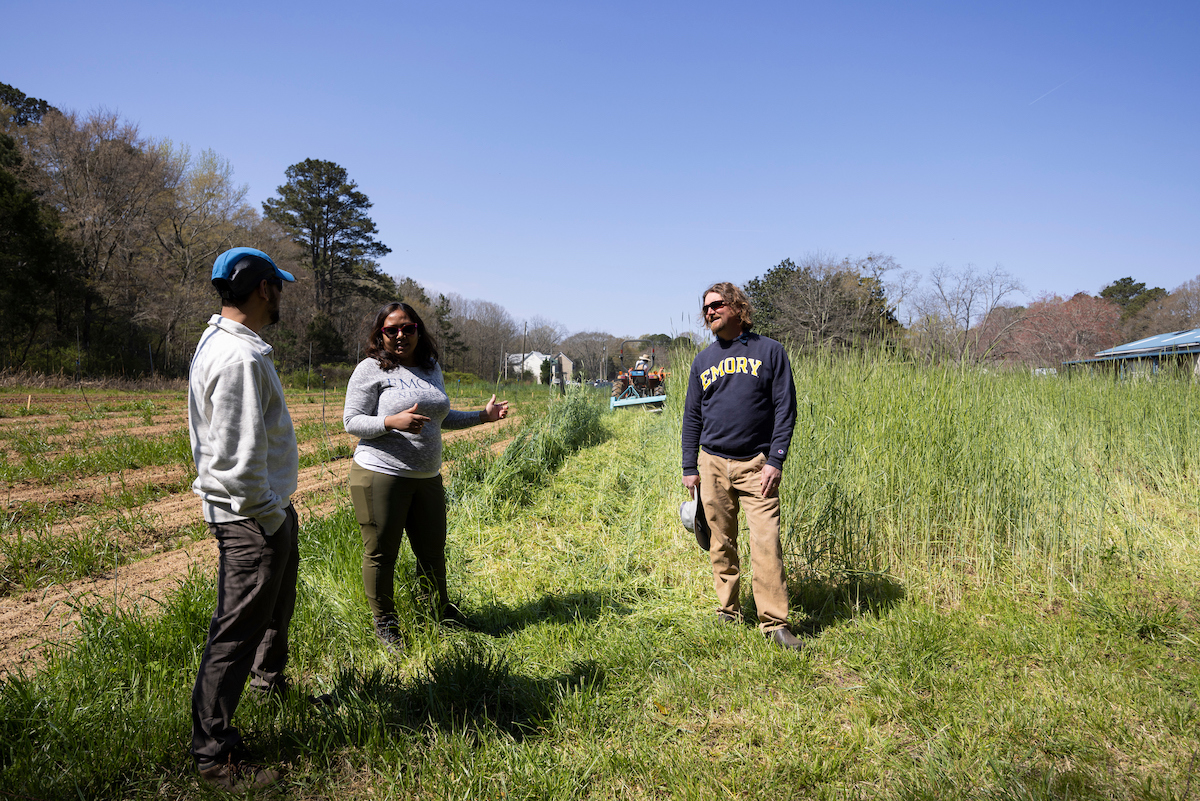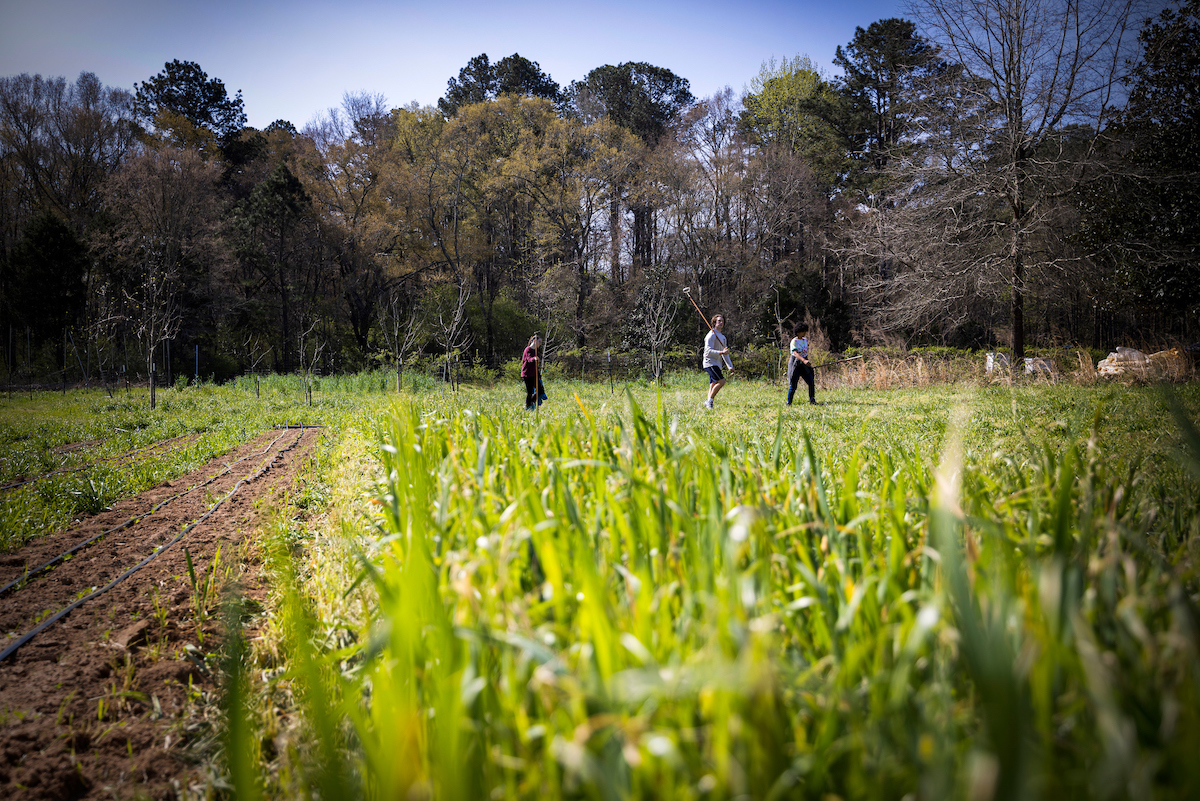From Georgia to Maine and points in between, Emory College environmental scientist Debjani Sihi got her hands dirty this summer in an effort to see how soil might help battle climate change.
As a biogeochemist, Sihi is leading multiple projects to learn how soil can trap or emit carbon and other greenhouse gases in locations as varied as organic farms in Georgia, evergreen forests in Central Maine, and both coastal and inland wetlands.
She and a team of undergraduate, graduate and postdoctoral researchers then build and apply biogeochemical models that use that information to evaluate the impact of farming practices and general behavior on soil’s carbon capture and, in turn, greenhouse gas emissions.
“The goal is to improve our understanding of the mechanisms, processes and feedbacks of climate change,” Sihi says. “Overall, we are trying to find ways to solve climate change issues with more natural and nature-based solutions.”
Soil’s ability to sequester carbon gives it a foundational role in climate change. However, as we live through the hottest summer on record, the earth is also slowly drying out.
Poor soil quality can have relatively quick and large impacts on food production, as the Dust Bowl made clear nearly a century ago. Sihi was initially drawn to understanding the land management and agricultural side of environmental science as a way to make a notable impact on those problems.
For instance, her team received funding support from Valent BioSciences for a soil-carbon sequestration project launched last year at the Oxford Organic Farm, across the street from Emory’s original campus in Oxford, Georgia.

Environmental scientists Biswanath Dari and Debjani Sihi speak with Daniel Parson at the Oxford Organic Farm.
In the first year, Sihi and students built automated chambers for the soil’s greenhouse gas emissions and gathered soil samples before the farm planted crops in two areas that use different techniques.
“It’s groundbreaking work, no pun intended,” says Aditya Kolisetti, a rising senior who began working in Sihi’s lab last year.
“We are working with soil in the way other scientists work with gut microbiomes,” adds Kolisetti, a chemistry major who enjoys how soil science connects biochemistry to mathematics, geology, statistics and physics. “It’s extremely vast, it’s extremely innovative and, above all else, there is an urgency to understanding it.”
Murray Sternberg, a rising senior in Sihi’s lab, recently won the Lester Research Grant from the Department of Environmental Sciences to conduct an honors thesis based on the climate-smart project at the Oxford Organic Farm.
Sihi and her doctoral student, Milon Barmon, are continuing research and outreach activities on other climate-smart agriculture practice and soil health through funding support from the U.S. Department of Agriculture.
This summer, Sihi co-led a similar project funded by the National Science Foundation with graduate student Yaxi Du and Dana Kahn, a 2023 environmental sciences graduate who is now pursuing a master’s degree in the field while working in Sihi’s lab.
That project examines methane emissions from soil in Maine’s coniferous Howland Forest to see if scientists could find the tipping point when northern forests go from absorbing to producing the gas.
Sihi also has continued a project funded by the U.S. Department of Energy (DOE), using heterogeneity of soil properties to predict greenhouse gas emissions from wetlands near the shores of Lake Erie in Ohio and Maryland’s Chesapeake Bay.
“What interests me is this is applied science that lets you see the benefits of your work,” Sihi says. “The outcome of my work is always to be useful and used to inform policy.”
Rising senior Jack Kagan was looking for meaningful ways to pursue his interest in the hard sciences when he discovered his major in environmental sciences on the earth and atmospheric sciences track.

Debjani Sihi has used the Oxford Organic Farm for some of her soil-carbon research.
After a semester in Emory disease ecologist Thomas Gillespie’s parasitology lab, Kagan began working with Sihi on the Oxford Farm project last year.
His experience looking at how land-use strategies affect carbon efficiency helped him land an internship from the U.S. DOE at the Pacific Northwest Laboratory this summer.
There, he worked on hyperspectral imaging of soil and other soil projects from the department as part of its Science Undergraduate Laboratory Internship program. He will bring that experience back to Sihi’s lab this fall.
“The more classes I take, the more of this work I do, the more things I find myself interested in,” Kagan says. “I love science. I love spending time outdoors. I like feeling that what I do matters. The versatility of Dr. Sihi’s lab gives me that freedom to explore it all.”

